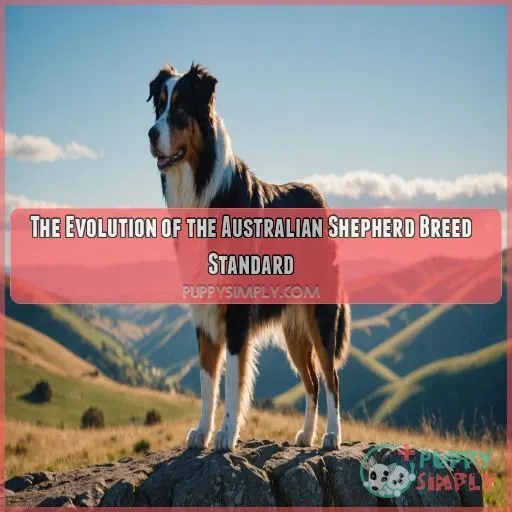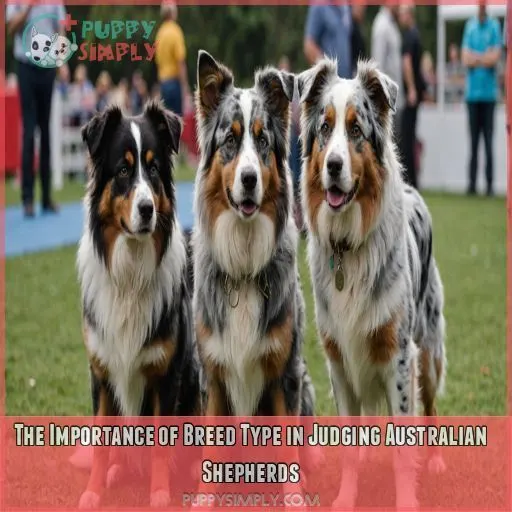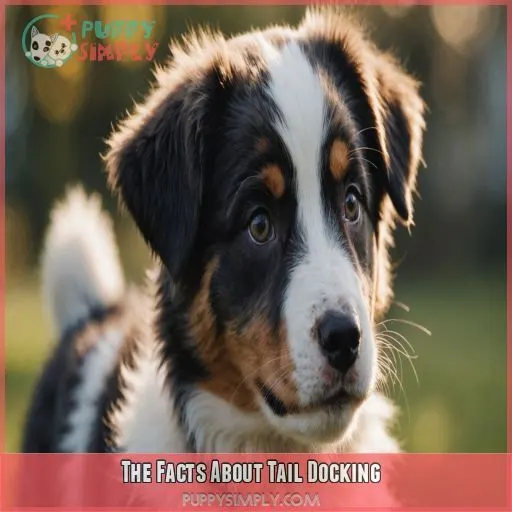This site is supported by our readers. We may earn a commission, at no cost to you, if you purchase through links.

Historically, tail docking was done to prevent injuries during herding, but many countries have since banned it for cosmetic purposes.
Breed associations like the USASA and ASCA prioritize the natural bob tail, considering it essential to the breed’s heritage.
But what’s the fuss about? Let’s explore the history of tail docking, its pros and cons, and what it means for your furry friend – and you might just learn a thing or two!
Table Of Contents
- Key Takeaways
- The Unique History of the Australian Shepherd
- The Evolution of the Australian Shepherd Breed Standard
- The Debate Over Full Tails in Australian Shepherds
- The Importance of Breed Type in Judging Australian Shepherds
- The Future of the Australian Shepherd Breed
- The Facts About Tail Docking
- The Debate Over the Necessity of Tail Docking
- Ethical Concerns Regarding Tail Docking
- The Future Outlook on Tail Docking in Australian Shepherds
- Frequently Asked Questions (FAQs)
- Should Australian Shepherds tails be docked?
- Do Australian Shepherds have naturally bobbed tails?
- Is tail docking cruel?
- Is dog tail Docking legal in Australia?
- Is tail docking necessary for Australian Shepherd working dogs?
- Do Australian Shepherds with docked tails make better pets?
- Can tail docking prevent injuries in Australian Shepherds?
- How do Australian Shepherds communicate without their tails?
- Are there health benefits to docking an Australian Shepherds tail?
- Conclusion
Key Takeaways
- The natural bob tail is a defining trait of the Australian Shepherd breed, with breed associations like the USASA and ASCA prioritizing its preservation as part of the breed’s heritage.
- Tail docking was historically done to prevent injuries during herding, but many countries have since banned the practice due to ethical concerns and a lack of scientific evidence supporting its benefits.
- As the Australian Shepherd’s popularity grows globally, it’s up to judges, breeders, and owners to ensure the breed’s unique characteristics, like the natural bob tail, are preserved for future generations.
- The debate over tail docking in Australian Shepherds is complex, with ethical considerations around animal welfare, dog communication, and long-term health implications that owners and breeders must carefully weigh.
The Unique History of the Australian Shepherd
As a breed developed by Western US ranchers, the Australian Shepherd has a fascinating history. From their focus on working dogs to the preservation of the natural bob tail, the Aussie’s unique origins have shaped its evolution over the years.
Origins and Development of the Breed
The Australian Shepherd is a relatively new breed, with its roots tracing back to ranchers in the western United States. Though the breed’s origins are a bit murky, early breeders focused on developing hardworking dogs, not purebreds. The natural bob tail became a defining trait of the Aussie as the breed evolved.
Ranchers’ Focus on Working Dogs
The early Australian Shepherd ranchers were all about practicality, not breed perfection. They focused on breeding dogs that could get the job done, handling livestock with skill and tenacity. These working pups weren’t show dogs – they were tough, versatile herders. The natural bob tail was simply a feature that helped them get the work done.
Preservation of the Natural Bob Tail
As the Australian Shepherd breed developed, ranchers recognized the natural bob tail as a desirable trait and worked to preserve it. This unique characteristic became a defining feature of the breed, setting the Aussie apart and shaping its breed standard for decades to come. Upholding this heritage continues to be a priority for the breed’s caretakers.
The Evolution of the Australian Shepherd Breed Standard
As the Australian Shepherd breed gained popularity, breed associations emerged to establish official standards. You’ll be surprised to learn how the breed standard’s treatment of the iconic bob-tail evolved over time.
Establishment of Breed Associations
In the 1960s, Australian Shepherd enthusiasts banded together to establish breed associations like the Australian Shepherd Club of America (ASCA) and the International Australian Shepherd Association. These organizations aimed to:
- Define breed standards
- Promote the breed’s unique characteristics
- Foster a community of ethical Aussie owners and breeders.
[/OUTPUT]
Recognition of the Natural Bob Tail
In the 1960s, the founding breed associations recognized the natural bobtail as a distinctive and desirable Australian Shepherd trait. This embrace of the breed’s unique genetic heritage set the stage for lively debates over whether full tails should be penalized or accepted. The bobtail remains a signature characteristic that connects Aussies to their hardy working dog roots.
Inclusion of Docking as an Option
As the breed standard evolved, docking was included as an option to address concerns about potential birth defects and promote uniformity. However, this move sparked debates, as many believed the natural bob tail was a defining trait that should be preserved. Breeders faced a tough choice – honor tradition or adapt to changing times.
The Debate Over Full Tails in Australian Shepherds
The tails of Australian Shepherds have long been a source of debate among breeders and enthusiasts. With tail docking bans sweeping across Europe, the discussion around the breed’s distinct natural bobtail has intensified, leaving many wondering whether full tails will become more accepted in the future.
Tail Docking Bans in Europe
The arrival of tail docking bans in Europe has sparked a heated debate over the future of full-tailed Australian Shepherds in the US. As judges and breeders grapple with this shift, they must consider the ethical concerns and legal implications of this practice while preserving the breed’s unique heritage and characteristics.
Statements From USASA and ASCA
Are you torn about whether your Aussie should have a full tail? The USASA and ASCA have your back! They believe the natural bob tail is essential to the breed’s heritage and want to preserve this unique trait. They’ll make sure your pup stays true to its Aussie roots, no matter how you decide to approach that tail.
Prioritizing the Natural Bob Tail
As an avid Australian Shepherd enthusiast, you know the natural bobtail is a defining trait. The USASA and ASCA are committed to preserving this heritage – they view full tails as deviations from the breed standard that should be penalized. By prioritizing breed type, you can help uphold the Aussie’s unique history and identity.
The Importance of Breed Type in Judging Australian Shepherds
As an Australian Shepherd owner or enthusiast, you know the breed’s iconic look and heritage are defined by its unique tail. When judging these pups, it’s really important to prioritize the natural bob tail – a key identifying trait that connects the breed to its storied past.
Key Identifying Characteristics
You’re about to judge an Australian Shepherd, but do you know what to look for? Let’s break down the key identifying characteristics of this breed.
| Characteristic | Description |
|---|---|
| Coat Color | Blue merle, black, red merle, or red, with or without white markings |
| Eye Color | Brown, blue, or amber, with a piercing gaze |
| Size | 18-23 inches tall, 35-55 pounds |
| Temperament | Intelligent, energetic, and loyal |
| Tail | Docked or naturally bobbed, not to exceed four inches |
Judging the Natural Bob Tail
When judging Australian Shepherds, the natural bob tail is a key characteristic to keep in mind. Here are some tips for judges:
- Prioritize breed type: The natural bob tail is an essential identifier, so make it a top priority when evaluating Aussies.
- Judge the bob tail: Assess the tail’s length, shape, and carriage. It should be short, straight, and upright.
- Deviation from the standard: Full tails should be penalized as they deviate from the breed standard and the Aussie’s heritage.
- Understand genetics: Know that the bobtail trait is caused by a specific gene, and Aussies can have full-length tails too.
- Health considerations: Make sure tail docking doesn’t affect tail health and the dog’s ability to communicate.
Considering the Breed’s History
When judging Australian Shepherds, consider the breed’s history and how it influenced their tail. Early breeders valued the natural bobtail, which was a result of their working heritage. Understanding this context helps you appreciate the breed’s unique characteristics. By acknowledging the breed’s past, you’ll make informed decisions about their tail and promote responsible ownership.
The Future of the Australian Shepherd Breed
You’re probably wondering what the future holds for the Australian Shepherd breed, especially when it comes to their iconic tails. As the breed continues to gain popularity worldwide, it’s up to judges, breeders, and owners like you to help preserve the natural bob tail that’s been a defining characteristic of this beloved breed.
Popularity Worldwide
The Australian Shepherd‘s popularity is growing globally.
You’re part of a community that’s passionate about this breed.
With varying regional preferences and show standards, it’s important to understand the impact of global demand on breed popularity.
Owner preferences also play a significant role in shaping the breed’s future.
What does this mean for the Australian Shepherd’s unique characteristics, like its tail?
Preserving the Natural Bob Tail
You’re part of the Australian Shepherd community, and keeping the natural bob tail is important. Here are 4 key considerations:
- Bobtail genetics: Understand the T-gene’s role in creating the breed’s signature trait.
- Docking alternatives: Explore humane options that prioritize the dog’s well-being.
- Breeder responsibility: Choose breeders committed to ethical breeding practices.
- Ethical considerations: Weigh the pros and cons of tail docking, prioritizing the dog’s quality of life.
Responsibilities of Judges and Breeders
As a judge or breeder, you play a major role in shaping the Australian Shepherd breed’s future. Your decisions impact the breed’s health, well-being, and conformity to breed standards. Consider the following:
| Responsibility | Action |
|---|---|
| Preserve breed type | Prioritize natural bob tails |
| Promote health | Monitor for tail injuries and health concerns |
| Uphold breed standards | Penalize full tails accordingly |
| Support ethical breeding | Encourage responsible breeding practices |
The Facts About Tail Docking
You’re probably wondering what all the buzz is about when it comes to tail docking in Australian Shepherds. Let’s get straight to the facts: tail docking is a surgical procedure that’s been debated among breeders, veterinarians, and dog owners, with many countries banning it due to animal welfare concerns.
Illegal in Many Countries
You’re probably aware that tail docking is a contentious issue, but did you know it’s illegal in many countries? That’s right, countries like Australia, Brazil, and those in the European Union have banned non-therapeutic tail docking due to animal welfare concerns. Here are three key points to keep in mind:
- Global ban: Many countries have outlawed tail docking for non-therapeutic reasons.
- Animal welfare: The ban aims to prevent unnecessary pain and suffering in dogs.
- Changing attitudes: As awareness grows, more people are questioning the need for tail docking.
Veterinary Organizations’ Stance
You want to know where veterinary organizations stand on tail docking? Here’s the lowdown:
| Organization | Stance on Tail Docking | Reasoning |
|---|---|---|
| AVMA | Condemns tail docking | No scientific evidence to support benefits |
| American Hospital Association | Opposes tail docking | Focus on animal welfare |
| Veterinary Associations | Discourage tail docking | Potential for chronic pain |
These organizations prioritize animal welfare and scientific evidence, advising against tail docking.
Debunking Historical Rationales
Let’s debunk some historical rationales behind tail docking. You’ve probably heard that it prevents rabies – but that’s just a myth. Others claim it’s necessary for work dogs to avoid injuries. However, studies show that tail injuries are rare, and docking can actually harm your Aussie’s behavior and health. It’s time to rethink this outdated practice.
The Debate Over the Necessity of Tail Docking
You’re probably wondering if tail docking is really necessary for your Australian Shepherd, especially since it’s a topic of heated debate among breeders and owners. As you weigh the pros and cons, you should really look into the facts and research on tail injuries in herding breeds, rather than relying on tradition or personal opinions.
Tail Injuries in Herding Breeds
When you’re looking into herding breeds, you’ll find that tail injuries are a concern. But are they common enough to justify tail docking? Statistics show that less than 1% of dogs experience tail injuries. You’ll want to weigh the risks and benefits of tail docking for your Australian Shepherd, considering their working style and environment.
Lack of Research
There’s a lot of back-and-forth on whether Aussie tail docking is necessary, especially when it comes to preventing injuries.
But here’s the thing: there isn’t a whole lot of research to back up those claims.
You won’t find many scientific studies showing that docking tails prevents injuries in herding dogs.
Low Incidence of Tail Injuries
The whole tail-docking debate boils down to one key question: How likely are tail injuries, anyway?
According to a large study on tail injuries in dogs, it’s pretty rare.
We’re talking less than 1% of dogs.
Ethical Concerns Regarding Tail Docking
Ethical concerns are sparking debate over the practice of Aussie tail docking. Should we cut it out due to animal welfare worries, or is it a harmless snip preserving a unique breed trait?
Dog Communication and Pain
As an Australian Shepherd owner, you know your furry friend communicates in unique ways. But did you know that tail docking can impact their pain signals? Since dogs can’t verbalize pain, we must recognize body language and vocalization cues. Here are key signs to look out for:
- Changes in tail-wagging patterns
- Whining or whimpering
- Avoiding touch or grooming
- Changes in appetite or sleep
- Increased sensitivity to touch or handling
Potential for Chronic Pain
When you consider tail docking, think about the potential for chronic pain. Research suggests that docked dogs may experience lingering discomfort and increased sensitivity to touch. This can lead to touch aversion and a lower quality of life for your Aussie. As a responsible owner, consider the long-term effects and explore alternative pain management options for your furry friend.
Long-term Health Implications
As you weigh the pros and cons of tail docking, think about the long-term health implications for your Aussie. Research suggests that tail docking can lead to chronic pain, tail sensitivity, and behavioral changes. Here are 4 potential health risks to keep in mind:
- Chronic pain: Lasting discomfort that can impact your dog’s quality of life.
- Tail sensitivity: Increased sensitivity to touch or movement.
- Behavioral changes: Fear, anxiety, or aggression related to tail handling.
- Health complications: Infections, allergies, or nerve damage.
The Future Outlook on Tail Docking in Australian Shepherds
You’re about to explore the future of tail docking in Australian Shepherds, and it’s looking more hopeful for those adorable tails. As you learn about the shift in favor of accepting natural tails, you’ll discover how breeders, social media, and supporters are making a difference in prioritizing the health and well-being of these amazing dogs (Source).
Breeders Choosing Intact Tails
As a responsible breeder, you’re now choosing to leave tails intact on your Australian Shepherds.
You’re prioritizing their natural bob tail, recognizing its importance in dog communication and overall health.
This shift to ethical breeding is a step in the right direction.
Social Media Groups Promoting Tails
There’s a growing movement of social media groups promoting Aussie tail pride.
These online communities celebrate the natural beauty of Aussie tails, encouraging breeders to reject docking and embrace the unique characteristics of their pups.
Join the tail-wagging community and proudly show off your Aussie’s natural tail!
You’ll find a thriving tail-wagging community on social media, passionate about natural tail advocacy.
Facebook groups, forums, and Instagram accounts celebrate the beauty of intact tails, sparking meaningful discussions around docked vs. intact and tail-docking ethics.
Join the conversation and connect with like-minded individuals who share your passion.
Many social media groups are now promoting Aussie tail pride, raising awareness about the ethics of tail docking.
Join the movement and connect with like-minded owners who value natural tail advocacy.
Together, you can celebrate the unique characteristics of the breed.
Supporting Ethical Breeders
When searching for an Australian Shepherd breeder, consider these key things:
- Tail-docking alternatives: Look for breeders who prioritize puppy health and offer alternatives to tail-docking. You can find these breeders by joining online Aussie groups or looking for breeders who openly discuss their practices on their websites.
- Puppy health guarantees: A good breeder will offer health guarantees for their puppies, giving you peace of mind.
- Responsible breeding practices: Make sure the breeder follows ethical breeding practices that meet the specific needs of the Australian Shepherd breed.
- Breed associations: Check if the breeder is affiliated with reputable breed associations. These associations often have codes of ethics that breeders must follow.
- References: Ask for references from other happy Aussie owners. They can give you valuable insights into the breeder’s practices and the puppies they produce.
Frequently Asked Questions (FAQs)
Should Australian Shepherds tails be docked?
Facing the age-old question: should tails be docked? Frankly, many experts and organizations firmly advise against it, citing animal welfare concerns and a lack of scientific evidence supporting its benefits. Consider your Aussie’s overall well-being instead.
Do Australian Shepherds have naturally bobbed tails?
You’re curious about Australian Shepherds’ tails. Well, some Aussies are born with naturally bobbed tails, thanks to a specific gene mutation. If an Aussie inherits this gene from both parents, they’ll likely have a shorter tail.
Is tail docking cruel?
Imagine cutting off a key part of a dog’s happiness – that’s what tail docking can feel like. Research suggests it may lead to chronic pain and negatively impact their ability to communicate emotions, making it a cruel practice.
Is dog tail Docking legal in Australia?
You’re wondering if dog tail docking is legal in Australia? Well, the answer is no, it’s been banned nationwide since 2004, unless it’s for therapeutic purposes or in the dog’s best interests (Source).
Is tail docking necessary for Australian Shepherd working dogs?
Picture a hardworking Australian Shepherd, its tail wagging wildly as it herds sheep. But is tail docking necessary for these working dogs? Nope! Research shows it’s more of a cosmetic tradition than a preventative measure for injuries.
Do Australian Shepherds with docked tails make better pets?
You’re wondering if an Aussie with a docked tail makes a better pet? Honestly, it’s not about the tail – it’s about the dog’s individual personality and needs. What matters most is finding a furry friend that’s a great match for you!
Can tail docking prevent injuries in Australian Shepherds?
You’re wondering if tail docking is like a force field for your furry friend. Sadly, research says nope! Tail docking doesn’t prevent injuries, and it may even cause more harm than good in the long run.
How do Australian Shepherds communicate without their tails?
You’re probably wondering, how do Australian Shepherds communicate without their tails? Well, they use body language, ear positions, and vocal cues to convey emotions and intentions, but it’s not as effective as their natural tail language.
Are there health benefits to docking an Australian Shepherds tail?
You might be wondering if docking an Australian Shepherd’s tail has any health benefits. Actually, research suggests that the risks outweigh the benefits, and many veterinary organizations condemn the practice (Source). So, what’re you to do?
Conclusion
The Australian Shepherd with a tail docked is more than just a pretty face.
With their rich history and natural bob tail, it’s no wonder breed associations prioritize this unique feature.
While the pros and cons of tail docking continue to be weighed, one thing is clear: the Aussie’s tail is a defining characteristic that deserves respect and consideration.















